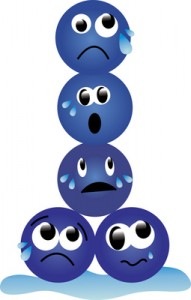 I remember when my oldest son absolutely insisted he would only eat blue food. His primary motivation was the blue ice cream – I don’t even recall the flavor or the name – that was Baskin Robbin’s new special fantastic flavor. I do remember that it left my son’s mouth an incredible shade of turquoise.
I remember when my oldest son absolutely insisted he would only eat blue food. His primary motivation was the blue ice cream – I don’t even recall the flavor or the name – that was Baskin Robbin’s new special fantastic flavor. I do remember that it left my son’s mouth an incredible shade of turquoise.
Fortunately the blue food phase didn’t last very long – in part because finding true blue food is not an easy task, some say impossible — and because Mom didn’t give in. Blue M&Ms and blue ice cream didn’t count, and still don’t, as true blue healthy food.
Why Should You Care About Blue?
Three plus centuries BC, Hippocrates, the Greek physician and a proponent of a plant-based diet said, “Let food be your medicine and medicine be your food.” Predating Hippocrates, traditional Asian diets were plant based and the belief was that they played a significant role in disease prevention — wisdom now supported by modern research.
The vibrant colors of plants give us clues about their healthy components. More color probably means more of the good stuff. But why are vibrantly colored foods so healthy? The answer lies in the phytochemicals which are manufactured by the plants to protect themselves from animal or insect damage, photosynthesis, and radiation.
The phytochemicals we eat give us the same protection that they give plants. Phytochemicals aren’t technically classified as nutrients but they are associated with disease prevention and treatment. You know if a plant food is rich in phytochemicals because it’s vibrantly colored.
Those vibrant blue, purple and red foods are filled with anthocyanins, which are water-soluble phytochemicals, that typically have a red to blue color. Anthocyanins, the pigments that make blueberries blue, act as powerful antioxidants which help neutralize harmful byproducts called “free radicals” that can be the precursors of cancer and some age-related diseases.
In your body, the antioxidant process is similar to what stops an apple from browning. Once you cut an apple, it begins to brown, but if you squirt it with lemon or dip it in orange juice, both of which contain vitamin C, it stays white.
Is There Really Blue Food?
Good question. True blue food is rare in nature, some say non-existent. But, wait a minute – what about blueberries, blue potatoes, blue lobster, blue corn, blue crab and that rare blue mushroom along with some other exotic foods?
There’s some thought that because blue doesn’t exist in significant quantity as a natural food color, we haven’t developed an automatic appetite response to blue food. The primal nature of humans is to avoid food that is poisonous. Multiple millenia ago — when our ancestors foraged for food — blue, purple and black were “color warning signs” for food that was potentially lethal.
Some believe that the foods we consider to be blue are actually purple – even though they may appear to be blue. As for blue cheese – well the blue veining is indeed blue, but it doesn’t seem to count because the blue veins are not naturally occurring. And, since blue lobster and crab turn red when they’re cooked – are they really blue foods?
It is an argument that could make for great dinner table conversation or excellent trivia questions. The thing to remember is that food that is in the range of blue or purple or red is filled with those marvelous phytochemicals that are great for you.
Blueberry: The Classic Blue All Star
The blueberry is a native American species. When the Pilgrims settled in Plymouth in the winter of 1620, their neighbors, the Wampanoag Indians, taught them survival skills: planting corn and using native plants, like blueberries, to supplement their food supply. The colonists learned to gather berries, dry them in the sun, and store them for winter. Blueberries eventually became a really important food that was preserved and canned. A beverage made from blueberries was a staple for Civil War Soldiers.
Blueberries, both fresh and frozen, especially the tiny wild blueberries, are truly all stars. One cup has about 80 calories and virtually no fat. They rank first in antioxidant activity when compared to forty other common fruits and vegetables. Concord grape juice ranks second with about two thirds of blueberries’ antioxidant activity followed by strawberries, kale, and spinach.
I frequently see “true-blue” blueberries during the summer blueberry season. I suspect that true-blue blueberry growers refer to their blueberries as blue not purple. But whether blue foods are blue only in the eye of the beholder and technically purple to the color purists and food scientists, reaching for whole and natural foods that come from that gorgeous end of the blue/purple/red color spectrum is one giant component (among many) of a healthy diet.

Leave a Reply